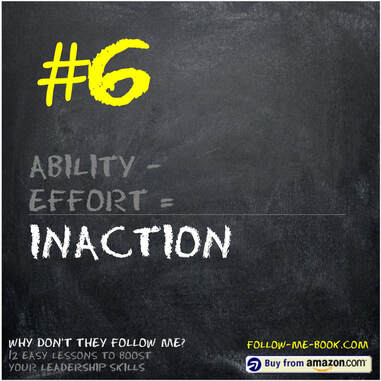
In Part 1: Ten Differences Between a Secure and an Insecure Leader, I contrasted ten key attributes that distinguish a secure leader from one who is insecure in his or her abilities. Part 2 is dedicated to giving you eight nuggets to help you succeed under an insecure leader.
For years I was an insecure leader. My greatest fear in leading others was that I would be "found out" and that everyone would see me not as a strong, competent leader but as a bumbling fool. Through the years I've learned that the quest for infallibility is impossible to reach and that making mistakes is part of the growth process. I'm less insecure today because I am more comfortable saying "I don't know" without everyone in the room thinking I'm an incompetent twit. Having said that, I am secure in knowing I will continue to screw up until my Maker calls me home.
1 Comment

Some time back I was reminded about a crucial attribute that all seasoned leaders possess. What surprised me was that it didn't come from what I do in my work life, it came from an interaction I had with my then 15-year-old son.
Sparing you some of the gory details, we had a situation where my son and I had to have some "man talk" where I expressed some displeasure with his behavior. It wasn't pretty and was very uncomfortable for him and not at all pleasant for me. Given that I took some huge withdrawals from the emotional bank account with him I recognized that I needed to have a more grounded follow-up discussion with him the next day.
|
Topics
All
Reprints
Contact Lonnie about article reprints. Please specify article you wish to reprint. Backlist
See Lonnie's Amazon Author Page Archives
July 2024
|
Lonnie Pacelli - Building Thriving Leaders™
Insightful | Creative | Direct Advice to Help Leaders Help Themselves
Keynote Speaker | Board Director | Autism Advocate | Author | Project Management Expert | Microsoft/Accenture Veteran
See his books on Amazon
Insightful | Creative | Direct Advice to Help Leaders Help Themselves
Keynote Speaker | Board Director | Autism Advocate | Author | Project Management Expert | Microsoft/Accenture Veteran
See his books on Amazon
Services |
About
|
© COPYRIGHT 2019. ALL RIGHTS RESERVED.
We are a participant in the Amazon Services LLC Associates Program, an affiliate advertising program designed to provide a means for us to earn fees by linking to Amazon.com and affiliated sites.
|


 RSS Feed
RSS Feed